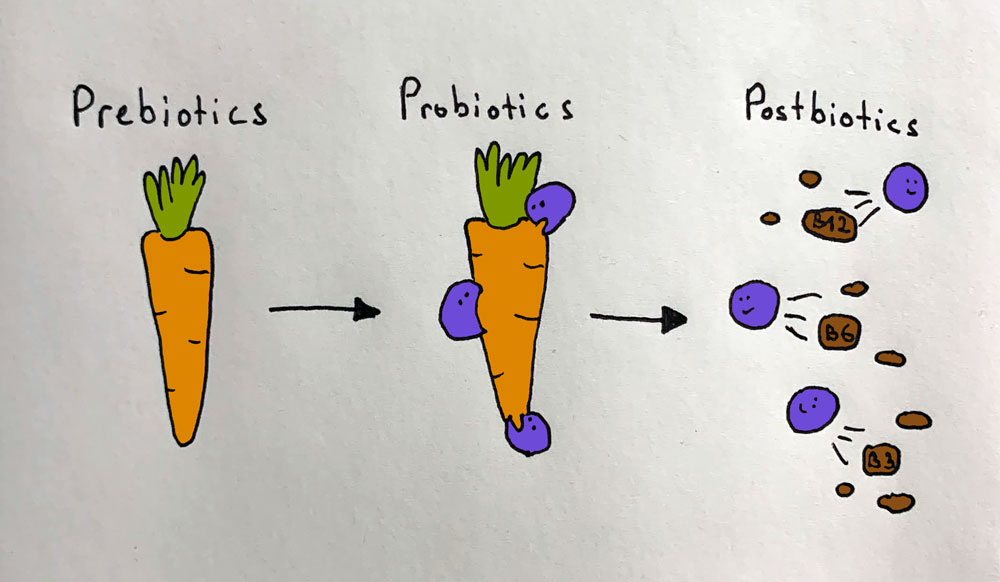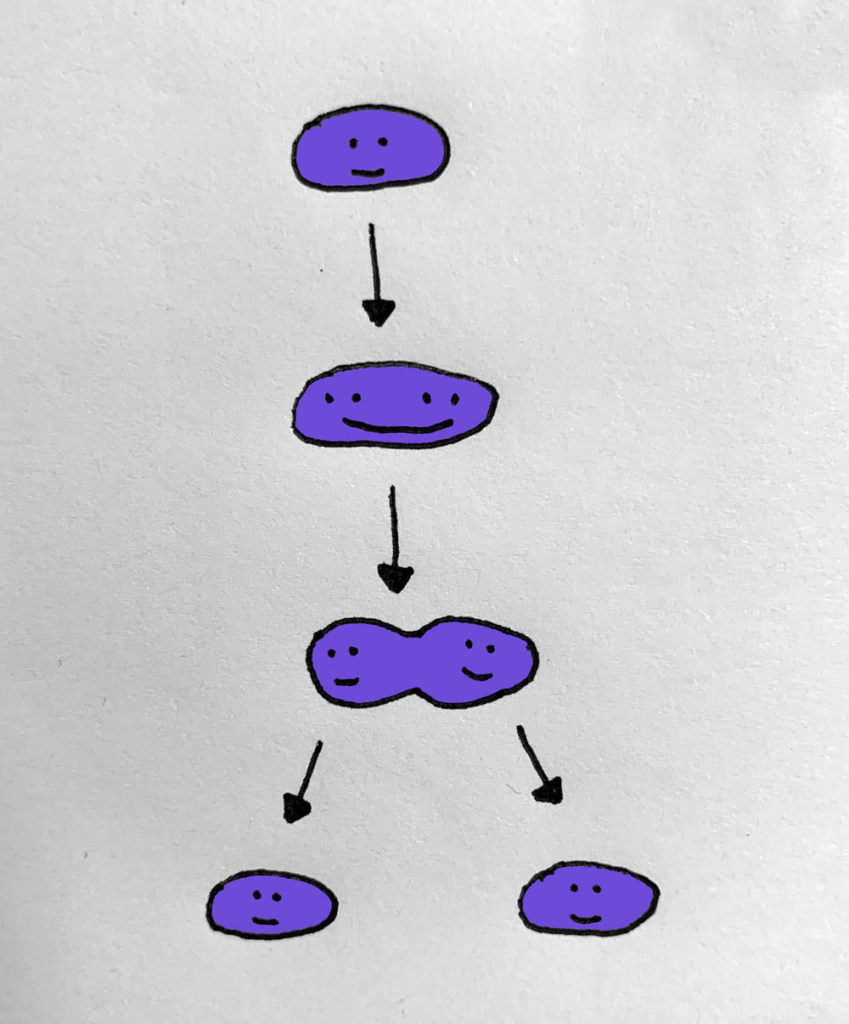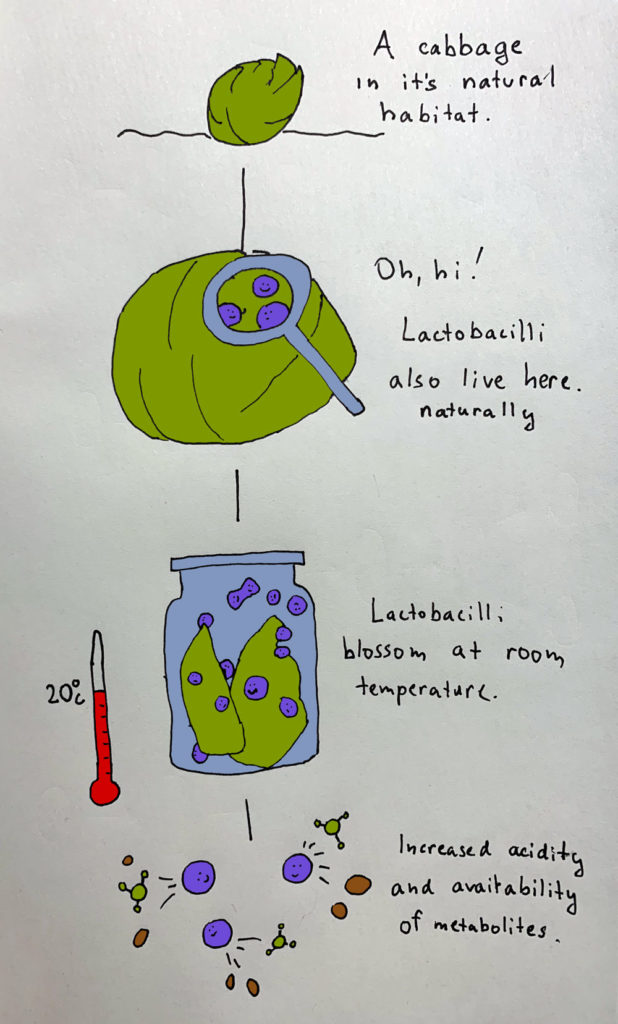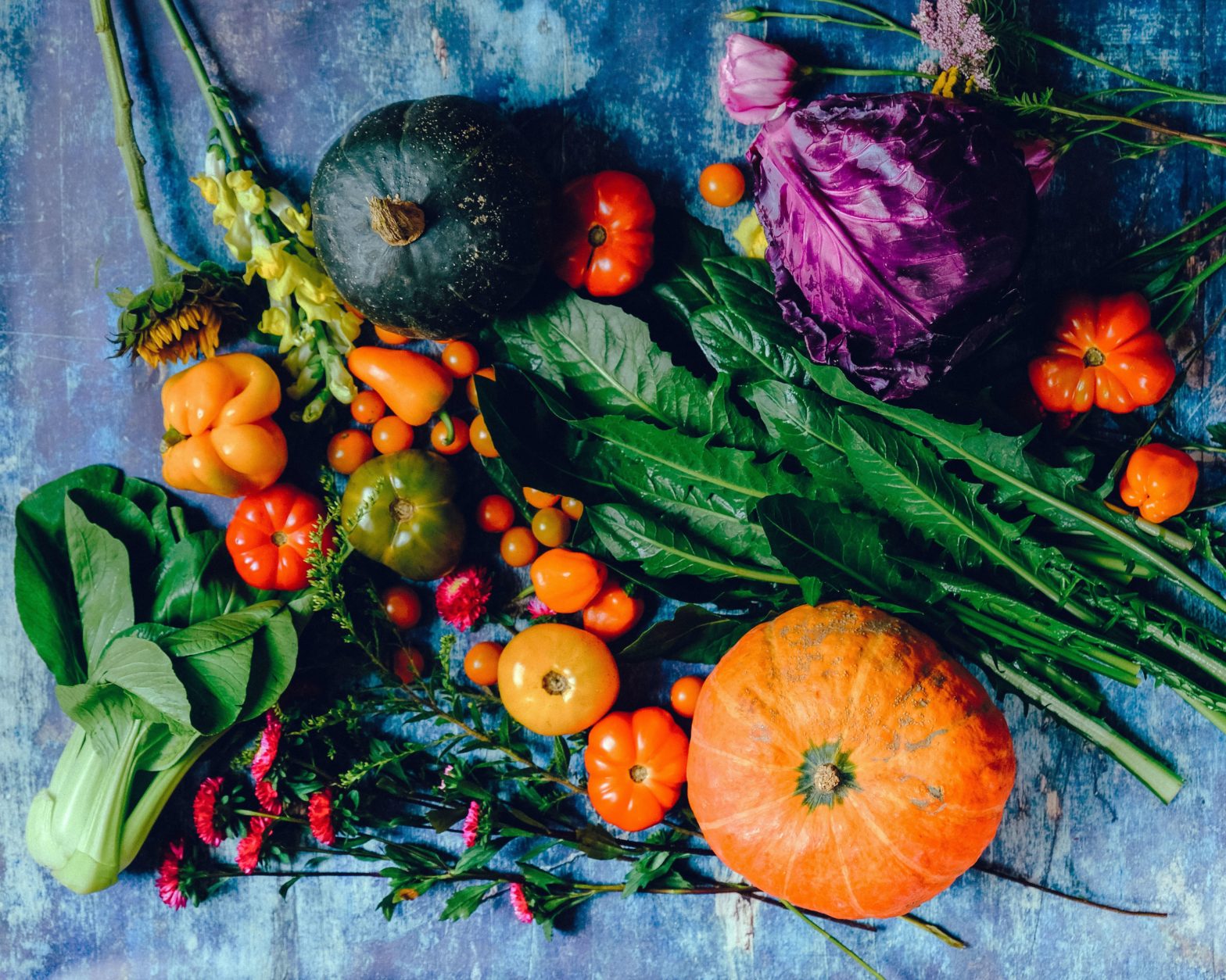What are Probiotics?
Our bodies contain many kinds of microorganisms – this community of organisms living in and on our body is called the microbiome. Probiotics are part of this microbiota. Usually probiotics are living bacteria.
If we think of bacteria we immediately think of it as a negative impact – something that makes us sick. However not all bacteria are bad. We have two kinds of bacteria in our body: “good bacteria” and “bad bacteria”.
Good bacteria usually fights off the bad bacteria, but if we get sick or eat too many saturated fat foods then bad bacteria can start to spread more in our body.
So we often need help from other sources. Best way to help our gut in this case is to take the right probiotics that balances the spread of bacteria.
Probiotics can be found in most fermented foods (kimchi, kombucha, sauerkraut, pickles, miso, yoghurt, kefir, sour milk), food supplements and even in beauty products. The main benefit of probiotics is promotion of digestion, production of vitamins and destroying harmful cells.
For probiosis to be truly effective we need to create the right environment for the good bacteria. To understand this let’s take a look at the prebiotic-probiotic-postbiotic lifecycle.
How do Probiotics Work?
The probiotic lifecycle can be most simply conceptualized using three components:

1. Prebiotics
The type of bacteria that grows in our body is strongly in correlation with the food we eat. The food we eat acts as food for the bacteria as well. If the bacteria has the right fuel – then it will grow and produce good stuff for our body. We call this fuel prebiotics – compounds that induce the growth of good bacteria.
2. Probiotics
So far we know that probiotics are good bacteria that live in our gut. But to be more specific: Probiotics are live microorganisms which can boost your health if taken in the right amount. Mostly this will be bacteria, but in some cases it can also be yeast or fungi that is beneficial to us. These microorganisms can also be found on your skin, in your airways and in your urinary tract.
3. Postbiotics
Postbiotics are bioactive components that are generated by bacteria. For example during fermentation beneficial byproducts such as enzymes are released. Some vitamins and minerals become more available as a result of fermentation such as the b vitamins and minerals zinc, calcium and iron.
Where do Probiotics Come From?
Probiotic supplements in the form of pills are usually isolated from various sources and then grown in laboratories.
Bacteria also exists naturally in our environment – it is in the ground and in the air. As a result this bacteria sets home on some foods, where the conditions are optimal. This bacteria is further grown in the process of fermenting the food. For example lactic acid bacteria already exists as part of the natural flora of vegetables. This is how sauerkraut, kimchi, pickles and a lot of other fermented foods are made.
Probiotics originate from various sources:
- Vegetables – exists in the flora naturally. The vegetable is fermented to increase it’s probiotic contents.
- Grains (or more generally cereals) – exists in the flora naturally.
- Human gut or vaginal microflora – extracted and grown in laboratories.
- Breast milk – extracted and grown in laboratories.
- Animal milk – fermented to increase it’s probiotic content and shelf life.
- Ground – bacteria is extracted from the soil and grown in laboratories.
As a result of having the right nutrients the bacteria will grow. When the bacteria reaches double its original size, it will split into two new identical cells. These new cells and their descendants will continue to grow and split into new cells, forming millions of new bacteria.

Fermentation – The Process Behind Probiotics
What is this magical process and why is it so important for probiotics and a healthy gut? Fermentation is the process of where bacteria or yeast break down sugars or carbohydrates into alcohols or organic acids. Without fermentation microorganisms would not occur much benefit to foods or to our gut.
Our bodies are actually not that good in breaking down plant based food. Microorganisms help break down the carbohydrates and fibers in fruits, vegetables and cereals into simple sugars so that our bodies can absorb them better. This breakdown into simple sugars also paves the way for fermentation.

Fermentation is usually induced in food by lactic acid bacteria at room temperature (the temperature where the bacteria is most active). The food becomes more acidic, digestible and bioavailable as a result. As lactic acid bacteria is more tolerant to acidic environments, it can survive your stomach acids and continue to provide beneficial effects in your microbiome for some time.
Fermentation has various benefits:
- Improved shelf life. The increased content of good bacteria outcompetes other unwanted bacteria. Also the increased acidity is a limiting factor for growth for other types of bacteria (1).
- Improved taste and texture (2).
- Increased B vitamin content (3).
- Increased mineral content: calcium, zinc and iron (4).
Not all fermented foods contain probiotics though as they might go through treatment where the beneficial microorganisms do not survive. Also, not all microorganisms produce a health benefit – thus they are not probiotic.
What Affects Our Gut Microbiome?
A healthy microbiome is usually characterised by having a rich variety of bacteria in your gut. The gut microbiome composition varies in different stages of life and variety is known to decrease with age. Although correlation does not mean causation. It has been observed that some populations with longer than average life expectancy have diverse gut microbiota also in later stages of life (5).
In general your gut microbiome is affected by the following factors (6):
- Diet
- Geographical location
- Antibiotic usage and other drugs
- Antibiotic usage through the consumption of animal products!
- Illness and injury
- Hormonal changes
Diet
A poor microbial diversity is a result of poor diet (7):
- Low fruit and vegetable intake
- High consumption of Animal-derived protein
- High consumption of saturated fats.
- High consumption of refined grains, sugars, salt, alcohol and corn-derived fructose
A good microbial diversity is a result of good diet:
- Fruits
- Vegetables
- Fiber (for example unprocessed grains)
- Plant-derived protein
- MUFAs – monounsaturated fatty acids (avocados, olives, almonds)
- PUFAs – polyunsaturated fatty acids (nuts, pumpkin seeds)
Are Probiotics Vegan?
Most lactic acid bacteria that is used as probiotics belong to the Lactobacillus family and are derived from milk. There is also a plant derived Lactobacillus member called Lactobacillus plantarum. Look for probiotics that are either plant or human gut derived if you want to make sure no animals were harmed in the process.
Prebiotic Types
Something that is not talked about so much is the importance of combining prebiotics with probiotics.
Cereals as Prebiotics
We can say grain-based prebiotics, which are a part of a natural everyday diet for most of the human population, are very promising. Prebiotics were considered as non digestible dietary fibre. The most common prebiotics are identified as vegetables and fruit fibres. But cereals have a bigger variety of fibres than any other prebiotics. Cereals and their fermented derivatives are very common in Asia and Africa. They are employed in the manufacturing of beverages, gruels, pancakes, fermented rice porridge, sorghum, maize, millet, non-cereal cassava and wild legume seeds. This kind of processing is very safe and it enhances nutritional value. Cereals have relatively long shelf life under ambient temperature, and are widely accepted by consumers including expectant/breastfeeding mothers, and sick/recovering persons.
Cereal products may offer healthier options for the delivery of probiotics than dairy products. Fermented oat milk-like beverages, which are rich in probiotic bacteria could be a compromise between cereal and milk diets.
Probiotic Types
Probiotics occur as many strains of bacteria. There are also a few yeasts that have probiotic effects. Gut microbiome analysis is recommened to find out which probiotics are best for you. You can ask your doctor for the analysis or check one of the recommended sites below.
Postbiotic Types
Butyric acid
Butyric acid is a short chain fatty acid produced by certain bacteria from high fiber sources such as oat bran via fermentation. It has 2 vital functions in our gut:
- Keeps the gut barrier healthy. It is the main source of energy for cells in your colon. Without butyrates your gut barrier cells will die.
- Helps T-cells change their gear. One of the most important gears – their immunity gear which enables handling of inflammatory and allergic responses.
Having an insufficient amount of butyrates is no joke and is strongly regulated by your diet. Not having enough can likely leave you with colitis, cancer or another disease in the long term.
Trimethylamine
Trimethylamine (TMA) is generated by bacteria from various animal-based proteins such as red meat, dairy products, eggs and salt-water fish. It is converted in the liver to a toxin called TMAO which is linked to atherosclerosis (8)). Thus it’s a good idea to limit the amount of animal-based protein intake.
Known Benefits
There is no doubt that probiotics have a positive effect on our bodies. Numerous clinical studies talk about the effectiveness of probiotics. They boost our immune system and have power to cure various diseases.
The bacteria in our gut regulate various aspects of our bodies:
- Weight regulation
- Immune system function
- Resistance to diseases
- Skin health
- Nervous system function
- Urogenital tract function
- Reproductive function
- Vitamin production
- Nutrient absorption
Weight regulation
Probiotics help us absorb more nutrients and calories from food. But controversially it has been shown that low gut microbiome diversity is linked to obesity (9). This means that there are other stronger factors related to our gut microbiome contributing to obesity other than our caloric intake.
High fat diets are directly linked to increased inflammation and weight gain (10)
Immune system function
Some of the proteins produced by probiotics have anti-inflammatory effects. (11) Bacteria also produce a protective layer of mucus in our intestine which prevents pathogens from reaching our internals. They also help regulate T-cell and M-cell function which are responsible for protecting our system from pathogens.
Resistance to diseases
The good microbiota protects your intestine from colonisation and overgrowth of various pathogens by production of antimicrobial substances, competing for nutrients and just by being there – leaving no sites for pathogens to colonise.
In addition to keeping pathogens away probiotics also balance our systems and as a result help alleviate various dysfunctions.
It has been shown that diet strongly affects our microbiome. A weak diet can cause a microbiome which is unbalanced or low in variety. A weak microbiome makes us more responsive to various diseases (12)
Probiotics are known to cure:
- Irritable bowel syndrome
- Diarrhea
- Helicobacter pylori gastritis
- Inflammatory bowel disease
- Non-alcoholic fatty liver disease
- Atopic dermatitis.
Clinical studies suggest to involve probiotics during treatment of:
- Obesity
- Insulin resistance syndrome and type 2 diabetes.
- Reported benefits of the prophylactic use of probiotics in different types of cancer and cancer- associated side effects.
It also appears that probiotics can help maintain skin health. The cosmetic industry has introduced a wide range of topical products enriched with probiotics.
Bacteria on the skin can prevent:
- Skin irritation (including sun irritation)
- Topical allergy
- Inflammation
- Acne
- Dandruff
- Alopecia
- Psoriasis
- Some evidence regarding prevention of skin cancer.
Metabolic Diseases
The dysbiotic gut is linked to obesity, type 1 and 2 diabetes, and non-alcoholic fatty liver disease. A diet based rich in prebiotic- fermentable fibre and whole-grain cereals, vegetables should reduce glycaemia, insulinaemia and also lowers blood cholesterol, body weight and fat. Excessive consumption of red meat increases the risk of cardiovascular diseases.
Skin health
In cosmetology prebiotics are widely used. These prebiotics restore and stimulate the beneficial probiotic bacteria and fungi living on skin. Moreover, balancing skin pH with prebiotics in cosmetics improves the hydration of surface layers of the skin and normalises its keratinisation and exfoliation.
Nervous System Function
Probiotics have been shown to produce chemicals that affect our nervous system. For example in one study rats were given a specific fermented soymilk. This substance had the same antidepressant effect as a common antidepressant drug, fluoxetine, but without the side effects normally associated with the drug, such as appetite loss and reduced body weight (13)
Urogenital Tract
The urogenital tract can be colonised by bacteria administered orally with or without prebiotics. Gut microflora interacts with the urogenital tract. Proper gut microbiome stimulated by oral delivery of prebiotics reduces the level of some uremic neurovascular toxins in patients with chronic kidney diseases. Proper prebiotic and probiotic supplementation should prevent kidney diseases and limit their progress.
Reproductive Function
Prebiotics and probiotics could also be helpful in men during reproduction. Half-year treatment with orally delivered synbiotic composition of lactic acid bacteria increases the volume of the ejaculate and the quality/quantity of spermatozoa.
How to Choose?
Not all people tolerate the same type of probiotics. It is quite common to have intolerance to dairy based probiotics. Some people however have intolerance to cereal based probiotics. You can keep an eye on your intake and see how you react to various foods and probiotics. If you want to be 100% sure that you are taking the right supplements and eating the right foods then precision testing is recommended.
Gut Testing and Analysis
You can take tests at the comfort from your home from the following sites
United States:
Estonia:
United Kingdom:
Probiotic Sources
Probiotics can be ingested from the following sources:
- Fermented foods
- Fermented beverages
- Lentil based beverages
- Oat and legume drinks
- Fermented plant juices
- Flaxseed kefir
- Fermented hemp/coconut milk
- Fermented tiger nut milk
- Supplements

